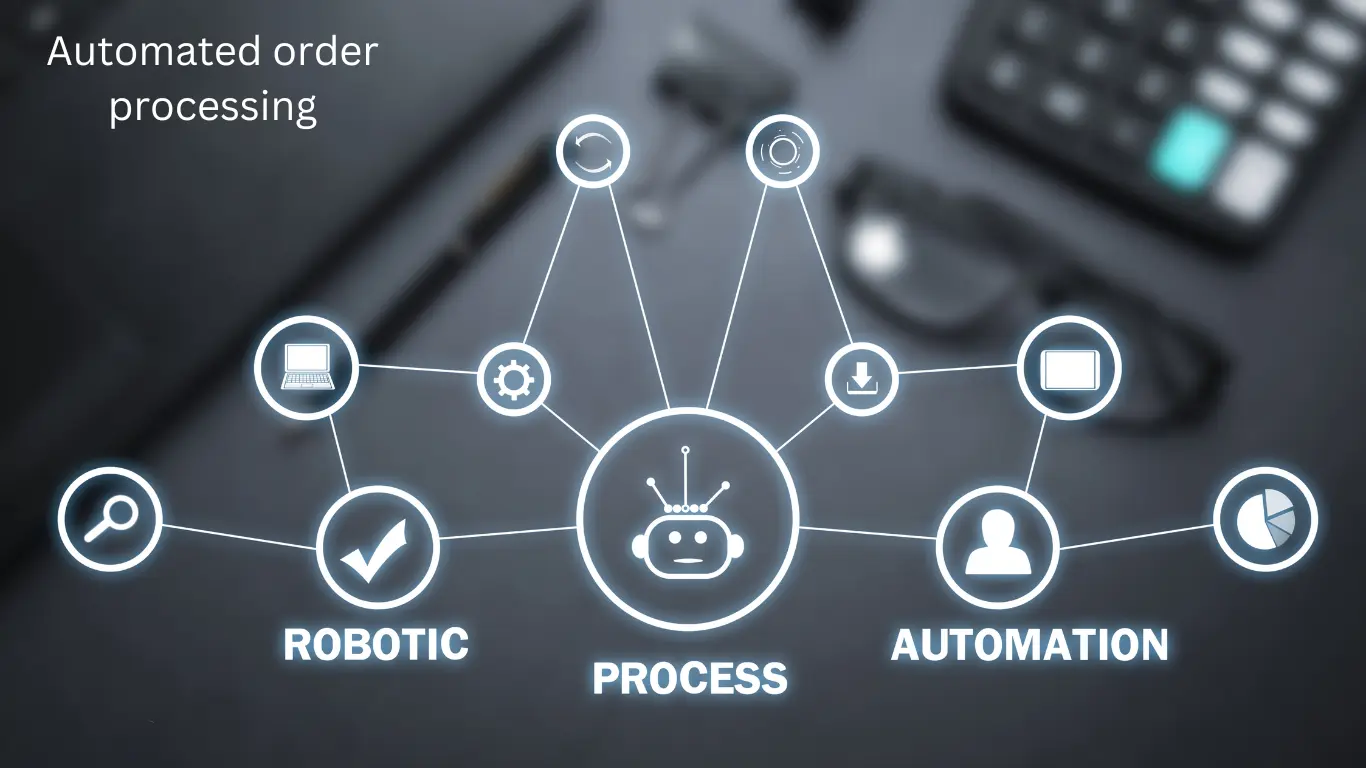Imagine if restaurants had to manually check an online food delivery platform like DoorDash every few minutes to see if a customer placed an order. The time spent manually checking for new orders could delay order preparation and delivery, or even cause some orders to be missed. Order processing in logistics encompasses the critical steps of receiving, picking, packing, and shipping customer orders, ensuring efficient supply chain operations.
Fortunately, automation helps restaurants stay on top of food orders more efficiently. The same concept applies to e-commerce. Automation is crucial for processing, as it speeds up delivery, reduces errors, and streamlines the entire order management process.
In this blog, we will take a closer look at what automated order processing is and how it can accelerate your e-commerce business.

Automated order processing refers to technology and systems that streamline the order process by reducing manual work. With automation, order processing has some features that can help reduce human error, improve operational efficiencies, and ultimately speed up the fulfillment and shipping process.
Automation in Key Order Processes
Order processing in logistics now relies on automation to streamline every step, from purchase order creation and verification to warehouse picking and fulfillment. Automated systems eliminate manual data entry, instantly verify and route orders, and integrate with inventory and warehouse management platforms for real-time tracking—all of which lead to fewer errors, faster fulfillment, and lower operational costs.
Purchase Order Automation
Purchase order automation replaces cumbersome manual workflows, enabling businesses to create, approve, and process POs quickly and accurately. Automation helps prevent costly mistakes, improves vendor relationships, speeds up procurement cycles, and provides deep visibility into spending and compliance controls.
Order Management Automation
Automated order management handles order intake, status updates, and fulfillment cycles through integrated cloud systems. This technology supports scalability, faster shipping, and enhanced customer satisfaction. Businesses can process high volumes from any channel, monitor every step, and provide customers with timely notifications, all while minimizing human intervention and errors.
Automated Warehouse Picking
Automated picking solutions work with order management and warehouse systems to assign tasks, generate picking lists, and optimize paths for warehouse staff or robots. The result is improved picking speed, reduction in mis-picks, and enhanced overall warehouse productivity. This integration reduces manual labor and ensures orders are picked, packed, and shipped efficiently with tracking updates pushed automatically to customers.
What is an Automated Order Processing System?
A fully automated order processing system integrates with an online store or even multiple sales channels, and automatically processes and verifies orders as they are placed online. From there, the order status is updated in real-time, customers are notified that the order is being processed, and the order fulfillment process can begin.
8 Benefits of Automated Order Processing Software:
By implementing automated process software, e-commerce businesses can significantly increase order management efficiencies and optimize their supply chain. Here are some of the key benefits of order processing automation:
Automatically Captures Sales Order Data Processing:
An automated order processing system receives and verifies customer orders and then directly enters them into a business’s processing or ERP inventory system. This prevents the need for constantly reentering information, such as customer details and delivery location.
Historical order data can later be used for demand forecasting and to provide other valuable insights to make better business decisions.
Collects Customer Data:
An automated system not only collects sales order data but also customer information, including order history, frequented delivery locations, and contact information. This data helps businesses improve the customer experience, provide better customer service, and make more informed, data-driven decisions.
Improves Accuracy and Eliminates Errors:
Manually inputting orders and customer data can lead to human error and inaccuracies, which can cause issues later in the order management process, such as fulfilling and shipping the wrong order. Automated processing software not only speeds up the process but also helps to reduce human error and improve order accuracy.
Streamlines Order Tracking with an Order Management System:
Automated order processing software can be integrated with inventory and warehouse management systems (WMS), providing significant data control. This minimizes the risk of human error and data loss while increasing data security.
All orders can be tracked from one portal, making it easier to monitor inventory and order status updates in real-time.
Decreases Order Fulfillment Costs:
Having an automated, fully integrated system to process orders can help save on fulfillment costs in the long run. It reduces the amount of labor needed to get an order out the door, and the process becomes much more efficient by eliminating manual order entry and tracking.
Provides Faster Shipping Times:
Order processing tasks such as order verification, shipping label creation, and printing can be automated. For businesses processing hundreds of orders or more monthly, setting up the ability to process orders automatically will help speed up the shipping process.
Enables Order Processing from Anywhere:
With automation, your team can process orders from anywhere by tracking orders in real time through the automated order processing system. Regardless of where an order is placed, it is automatically verified, processed, and sent to the nearest fulfillment centre.
Maintains High Customer Satisfaction:
Customers appreciate timely updates about their orders. Automated systems allow you to send customers notifications when an order is received, processed, being prepared, and shipped. Keeping customers informed about the progress at each stage, from processing to shipping, leads to fewer customer service inquiries and happier customers.
In the long run, employing an automated order processing system can take your e-commerce sales to the next level. The combination of all these advantages ultimately leads to a better customer experience. For example, by providing faster shipping times and decreasing your order fulfillment costs, you may gain a competitive edge through the option of lower prices. This can result in more customers, increased demand, and higher sales.
How Automated Order Processing Works with a 3PL:
Order processing automation is often used by larger, enterprise e-commerce businesses, but third-party logistics (3PL) providers can help introduce automation into your order management process to reduce time-consuming manual entry tasks.
When orders are placed on your store, they are automatically sent to a fulfillment center where the inventory is stored, and the sales order automation process can begin. Fulfillment experts then pick, pack, and ship orders, with tracking information automatically pushed to your store for sharing with customers.
Automating order processing can help streamline the fulfillment and shipping process, increase customer satisfaction, and improve operations. E-commerce merchants that partner with a 3PL can automate many aspects of the digital fulfillment process to save time and costs and scale their business more efficiently.
The Benefits of Automated Order Processing:
If you’re still on the fence, here are a few compelling reasons why automated order processing is worth the investment.
Minimize Errors:
Manual data entry, whether it’s updating inventory counts or managing customer details, often leads to mistakes. While some may be minor, others can have serious consequences—like sending the wrong product to a customer or delivering something different from what they ordered.
By automating order processing, your team can avoid the extensive data entry that often results in costly human errors.
Enhance Employee Experience:
Manually processing orders doesn’t just increase the risk of errors; it also leads to disengagement and dissatisfaction among your team. This can result in lower productivity and higher turnover rates.
Automation helps eliminate these repetitive tasks, sparing your organization from the negative impact they have on employee morale.
Boost Customer Satisfaction:
According to McKinsey & Company, about 1 in 5 consumers are willing to pay more for faster order fulfillment. This shows the high demand for speedy service.
With automated process, you can streamline your fulfillment process to meet customer expectations, ultimately fostering stronger relationships.
Scale Seamlessly:
As your business grows and order volumes increase, it’s crucial that your team’s efficiency isn’t compromised.
Automation ensures that tedious, time-consuming tasks don’t bog down your supply chain, allowing your business to scale without a hitch.
Reduce Costs:
The financial impact of human errors—whether it’s lost sales or the resources needed to fix mistakes—can quickly escalate as your business expands. Additionally, pushing employees to handle large volumes of manual tasks can lead to burnout and turnover, with the cost of replacing an employee often reaching twice their annual salary.
By automating the process, you reduce the likelihood of these costly scenarios, allowing your team to focus on higher-value tasks.
Conclusion:
Automated order processing is vital for e-commerce businesses looking to enhance efficiency, reduce errors, and meet customer demands for faster fulfillment. Implementing automation can lead to significant cost savings and scalability. For seamless integration, consider partnering with experts like Qodenext to optimize your order management process.
FAQ: What is Automated Order Processing?
1. Is automated order processing safe?
Yes, automated order processing is safe when implemented correctly, as it minimizes human errors and ensures secure data handling, reducing the risk of mistakes and data breaches.
2. What are the limitations of automated order processing?
Limitations include high initial setup costs, potential technical glitches, and the need for regular updates and maintenance to ensure efficiency and security.
3. Is automated order processing necessary?
Automated order processing is essential for businesses seeking to scale efficiently, reduce errors, and meet customer demands for faster and more accurate order fulfillment.
4. What is the difference between manual and automated order processing?
Manual processing relies on human entry and verification, whereas automated order processing uses integrated systems to handle order confirmation, data validation, inventory updates, and shipping tasks automatically.
5. How does automated order processing work in e-commerce?
It captures order details, verifies payment and stock availability, routes the order to a warehouse, creates shipping labels, and updates customers — all without manual input.
6. What are the main benefits of automated order processing systems?
It reduces human errors, saves time, improves order tracking, lowers fulfillment costs, enables scalability, and boosts customer satisfaction.
7. What technologies are used in order processing automation?
These include ERP and CRM integrations, warehouse management systems (WMS), barcode/RFID scanning, robotic picking, and AI-powered analytics.
8. Can automated order processing integrate with multiple sales channels?
Yes, modern systems sync data from e-commerce platforms, marketplaces, and POS channels to give real-time order and inventory visibility.
9. How can automation help reduce order fulfillment errors?
Automation minimizes manual data inputs by synchronizing payment verification, inventory allocation, and shipping label creation to maintain data accuracy.
10. What role does a 3PL (third-party logistics provider) play in automated order processing?
3PLs use integrated automation to handle picking, packing, and shipping, while automatically updating the client’s system with order and tracking data.







